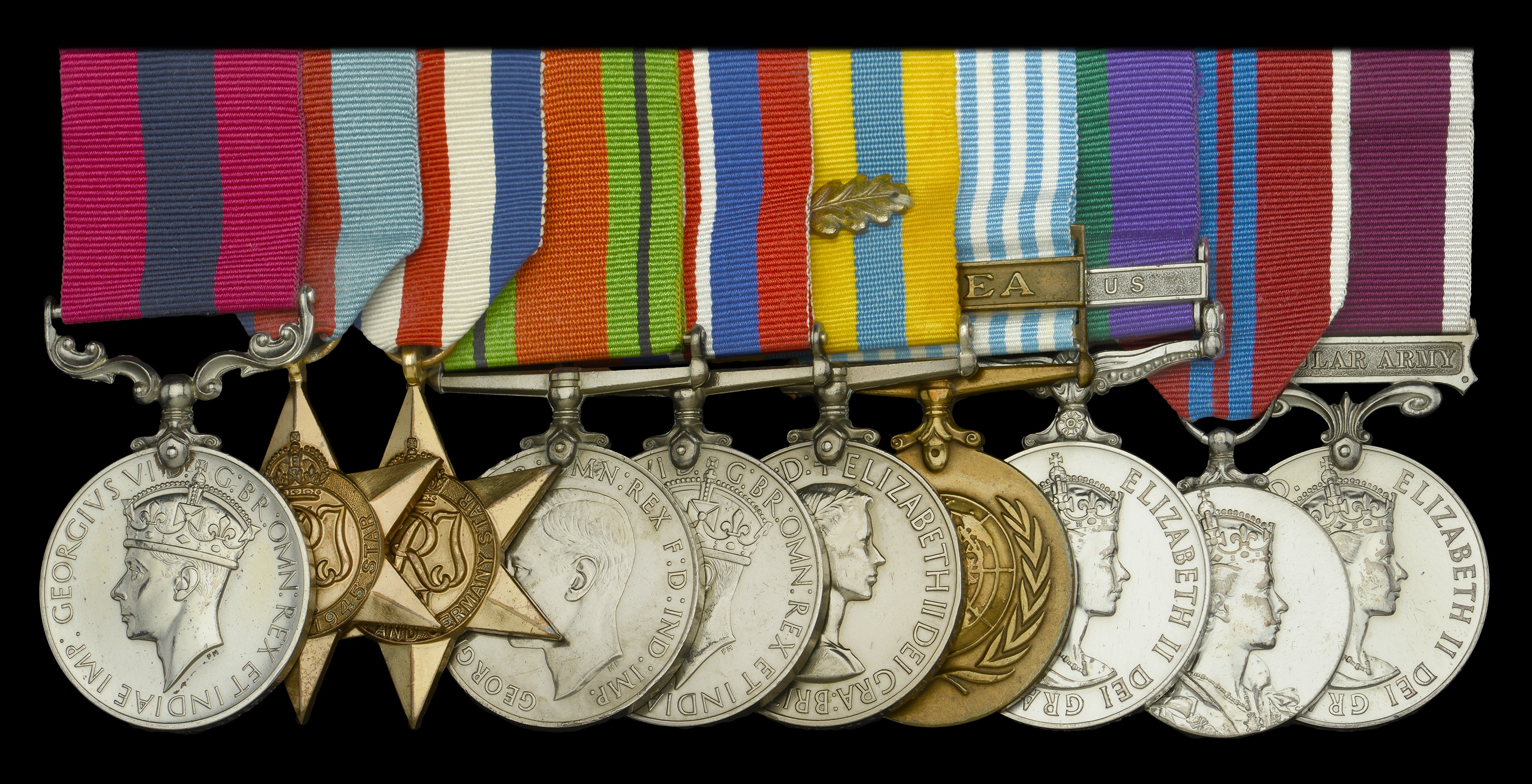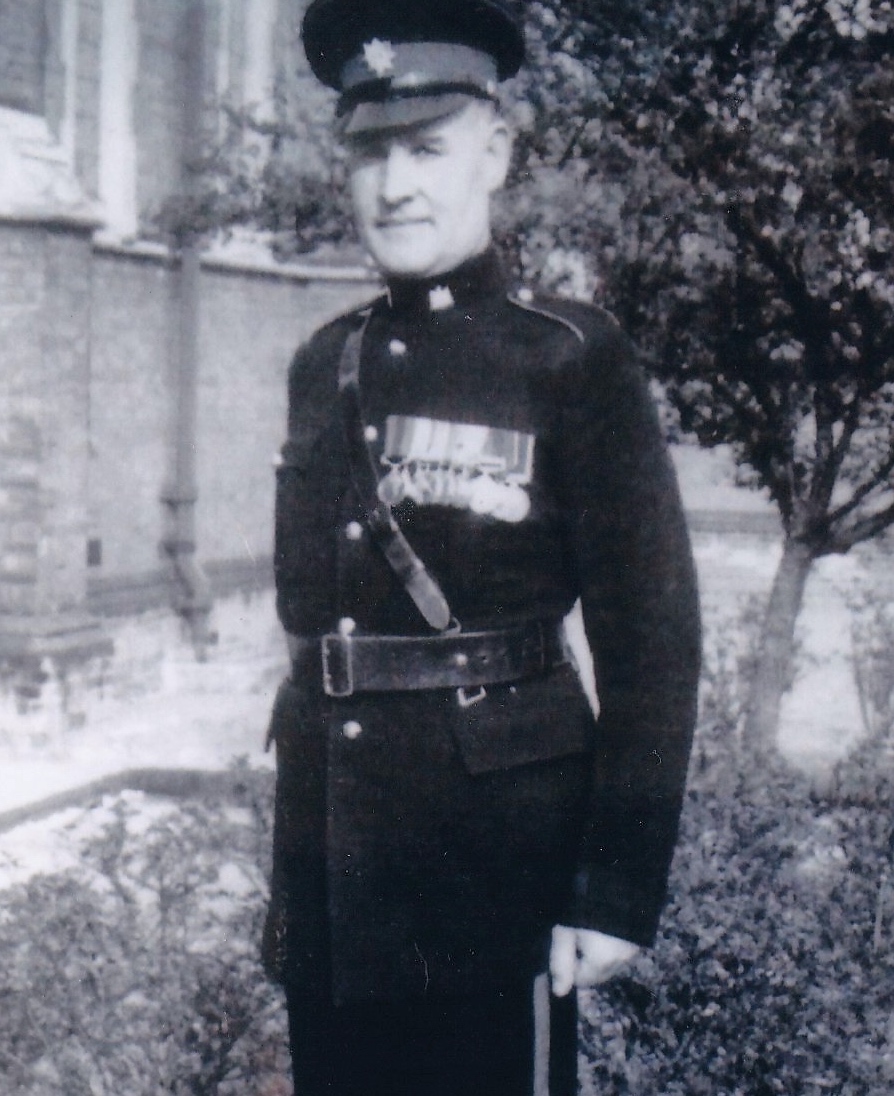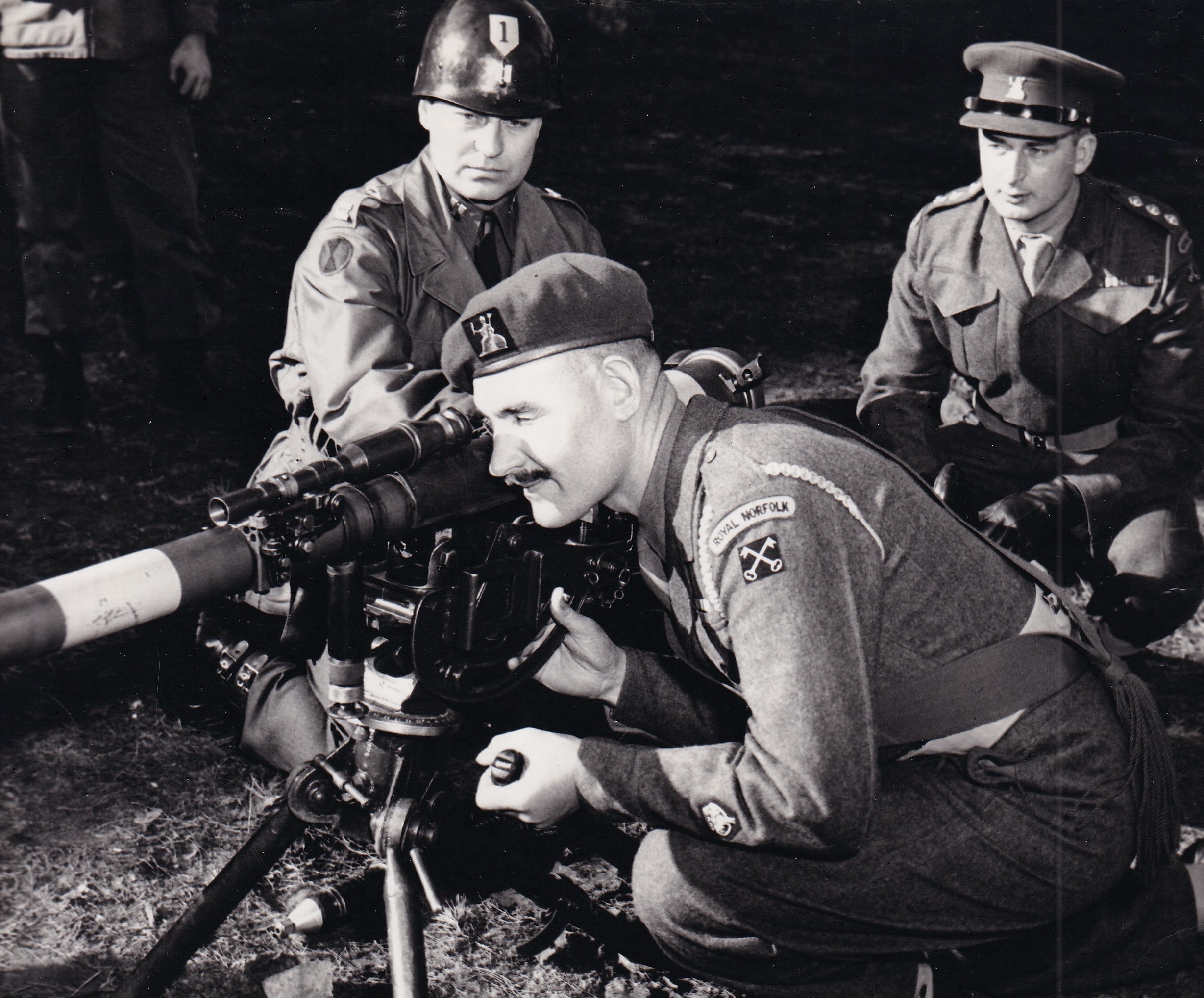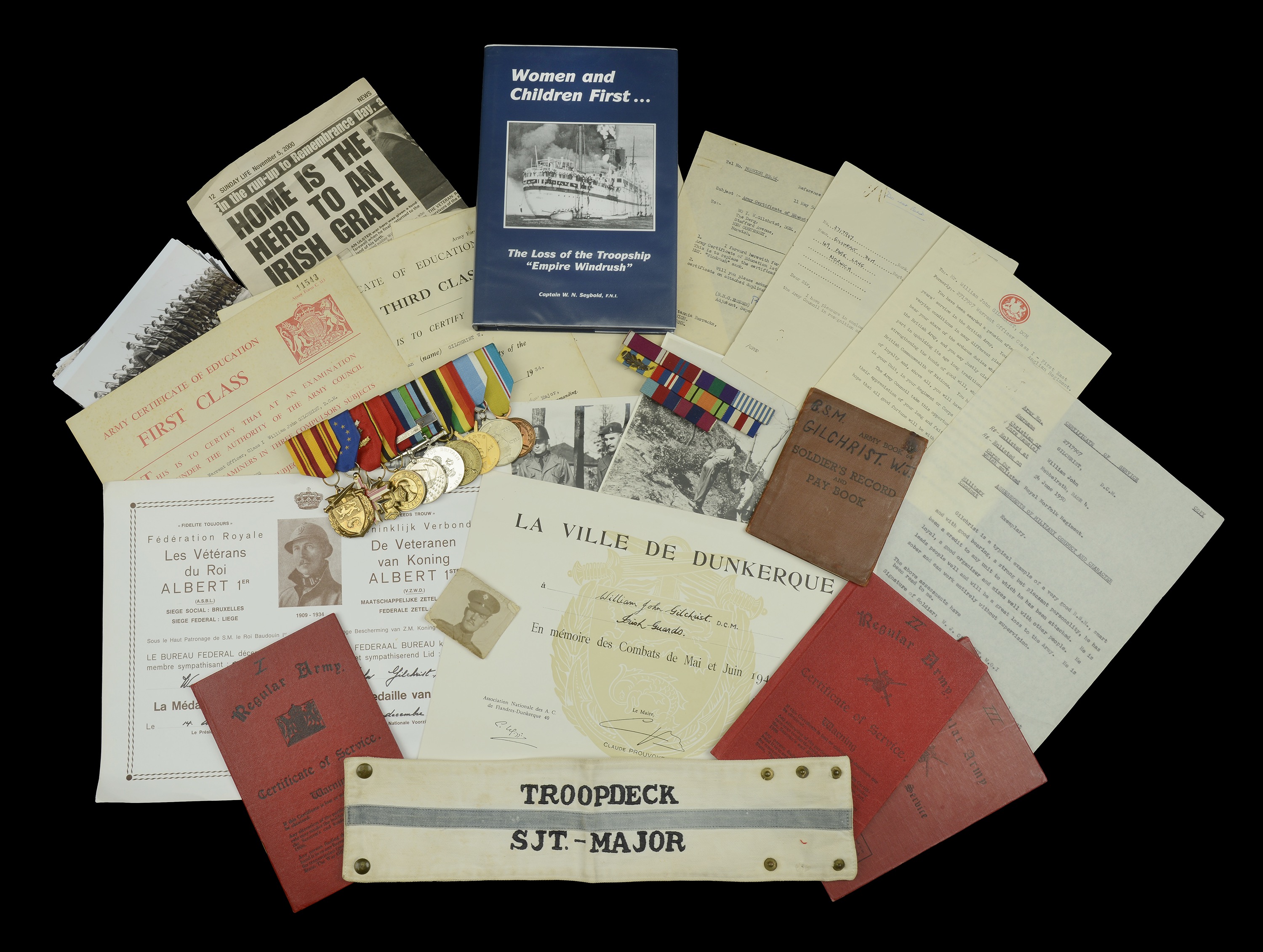An outstanding and well-documented Second War ‘Dunkirk 1940’ Immediate D.C.M. group of ten awarded to Regimental Sergeant-Major W. J. Gilchrist, Irish Guards, later Norfolk Regiment, who served with the Commando ‘Harpoon Force’ which evacuated the Dutch Royal Family just days before the country fell, and then distinguished himself in action against the German advance to Dunkirk which resulted in the knocking out of an enemy tank - despite being wounded by three bullets that tore through his helmet and left him blind for three months he refused to leave his post. Gilchrist saw later action post D-Day with the Irish Guards during their famous stand on the ‘Bridge too Far’ at Nijmegen, and then saw further service with the Royal Norfolk Regiment in Korea, for which he was Mentioned in Despatches Distinguished Conduct Medal, G.VI.R. (2717907 Sgt. W. J. Gilchrist. I.G.); 1939-45 Star; France and Germany Star; Defence and War Medals 1939-45; Korea 1950-53, 1st issue, with M.I.D. oak leaf (2717907 W.O. Cl.1. W. J. Gilchrist. R. Norfolk.) number and unit partially officially corrected; U.N. Korea 1950-54, unnamed as issued; General Service 1918-62, 1 clasp, Cyprus (2717907 W.O. Cl.1. W. J. Gilchrist. D.C.M. R. Norfolk.); Coronation 1953, unnamed as issued; Army L.S. & G.C., E.II.R., 2nd issue, Regular Army (2717907 W.O. Cl.1. W. J. Gilchrist. D.C.M. R. Norfolk.) good very fine (10) £4,000-£5,000 --- D.C.M. London Gazette 22 October 1940. The original Recommendation (for an Immediate award) states: ‘Boulogne 23 May 1940. Sergeant Gilchrist was in personal charge of an anti-tank rifle which protected the rear of the Battalion during its withdrawal into Boulogne on the 23rd May. For two hours this N.C.O., with a few men, succeeded in holding their post at a street corner, thus enabling the remainder of the Battalion to move on unmolested. Although under extremely heavy machine gun fire he showed the greatest contempt of danger and continued to keep his anti-tank gun in action. He was instrumental in hitting and setting on fire an enemy tank, thus blocking a street down which the enemy was trying to move. Later in the action he himself was wounded but refused to leave his anti-tank rifle until it and the Bren supporting it became jammed from over firing. Throughout the whole action Sergeant Gilchrist showed courage and bravery of a very high order and set the finest example to the remainder of his platoon.’ M.I.D. London Gazette 24 April 1953: ‘For gallant and distinguished service out in Korea in the period from 1st July to 31st December 1952.’ William John Gilchrist was born in Castlederg, Co. Tyrone, (Northern) Ireland on 15 August 1915, and attested for the Irish Guards on 16 January 1934. Posted to the 1st Battalion, by family repute he served for sometime at Batman to the future Field Marshal Earl Alexander of Tunis, before proceeding with the Battalion to Egypt in November 1936. Appointed a Lance Corporal, he transferred to the Army Reserve on 14 May 1938. Following the outbreak of the Second World War he was recalled from the Reserve, and posted to the 2nd Battalion. As such he remained on home service initially, but with the German invasion of France and the Low Countries, his battalion was ordered to depart from Dover for the Hook of Holland to cover the evacuation of the Dutch Royal Family and Government in May 1940 as part of what became known as Harpoon Force. Harpoon Force As the German blitzkrieg ravaged across Europe, old Kingdoms were been swept aside with impunity by the German army. The Dutch Royal family were next on the list and by late April 1940 their situation was on the brink. A 'Commando' style withdrawal was required. Major Haydon, Officer Commanding 2nd Battalion, Irish Guards, was called to arms in order to raise a small combined force to bring the Royal Family to Britain so they might rule in exile. Harpoon Force left off from Dover aboard Hereward. The invasion had taken everyone by surprise, so about a quarter of the men were on leave and couldn’t be reached through phone or telegram. With the landing planned for Walcheren the wider aims were: 1. Secure it for use of the Royal Navy; 2. Rescue the Royal family; 3. Evacuate embassy staff and other British citizens; 4. Cover the escape route from The Hague to Walcheren. Besides this the troops already in Holland were to try and secure any gold or diamonds and destroy as much as possible to damage anything the Germans might soon 'inherit'. Harpoon Force reached the Hook of Holland at dawn on 13 May to find the place in flames and had just docked when Stukas began bombing their ship and strafing them for good measure. They also found that it wasn’t just the enemy who were shooting at them. Some of the locals supported the German invasion and began taking potshots at the 2nd Battalion from several houses, forcing them to take cover. The Irish Guards had to get to The Hague to escort the Dutch royal family, but it was hard going even when members of the Dutch resistance came to their aid. The Dutch also warned them not to accept candy or cigarettes from any local because they were likely poisoned by Nazi-sympathizers. Since Haydon was given some leeway in his orders, he chose not to sacrifice anyone to The Hague. Walcheren was under siege, so securing it was hard enough. Besides the ship’s guns, all his battalion had were a few 3-inch mortar guns, the standard issue Bren guns, some anti-tank guns, and two signal trucks. By late morning, trucks began arriving from Amsterdam, but none carried the Royal Family. They instead brought diamond-filled crates which the sailors loaded onto the Hereward. To make room for more, they began unloading the ship’s stores for the use of the resistance. With the Germans still strafing them and still not a Dutch Royal in sight, Haydon finally gave the order to secure the roads between Walcheren and the docks. They hoped that some British nationals might make it out. Shortly after noon, a fleet of cars finally made it to the docks – the Royals were fashionably late! Haydon thus passed the work to Captain Thomas Halsey, of the Malcolm, but he came back with bad news: 'Nonsense! She left yesterday!’ Crossed wires meant that Queen Wilhelmina and her party were left standing on the dock, barred from boarding. It finally transpired that Princess Juliana had been evacuated the previous evening, so they eventually were given a berth. The problem was the Queen simply refused to let the ship leave. She was not going to leave her people without the Government, who finally arrived at six o’clock that evening. The Germans had spent the afternoon taking pot-shots and bombing the docks to keep themselves amused. Harpoon Force finally weighed anchor and took their precious cargo off, but at the cost of some 36 Guardsmen. Boulogne - Immediate D.C.M. With Holland falling just two days after they returned home, the 2nd Battalion were soon sent off to France to attempt to stem the tide. Posted to Boulogne, Gilchrist, by then a Sergeant, was part of an important 6-man team that attempted to hold off the German attack at Boulogne on 23 May 1940. It was at this stage that he earned an ‘immediate’ award of the Distinguished Conduct Medal. In gaining the D.C.M. Gilchrist had suffered when three bullets ripped through his helmet. Having stayed at his post until the very last, Gilchrist was pulled from his gun and evacuated home. By the time he reached England, he had gone blind and spent some three months in a blind hospital learning braille, before waking one day to find his vision restored. Gilchrist was then posted to the 3rd Battalion, Irish Guards, and shortly after his recovery found hi...















